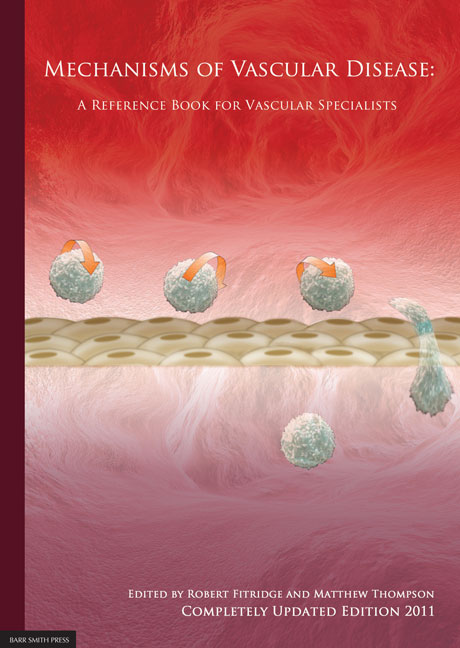Book contents
- Frontmatter
- Contents
- List of Contributors
- Detailed Contents
- Acknowledgements
- Abbreviation List
- 1 Endothelium
- 2 Vascular smooth muscle structure and function
- 3 Atherosclerosis
- 4 Mechanisms of plaque rupture
- 5 Current and emerging therapies in atheroprotection
- 6 Molecular approaches to revascularisation in peripheral vascular disease
- 7 Biology of restenosis and targets for intervention
- 8 Vascular arterial haemodynamics
- 9 Physiological Haemostasis
- 10 Hypercoagulable States
- 11 Platelets in the pathogenesis of vascular disease and their role as a therapeutic target
- 12 Pathogenesis of aortic aneurysms
- 13 Pharmacological treatment of aneurysms
- 14 Pathophysiology of Aortic dissection and connective tissue disorders
- 15 Biomarkers in vascular disease
- 16 Pathophysiology and principles of management of vasculitis and Raynaud's phenomenon
- 17 SIRS, sepsis and multiorgan failure
- 18 Pathophysiology of reperfusion injury
- 19 Compartment syndromes
- 20 Pathophysiology of pain
- 21 Post-amputation pain
- 22 Treatment of neuropathic pain
- 23 Principles of wound healing
- 24 Pathophysiology and principles of varicose veins
- 25 Chronic venous insufficiency and leg ulceration: Principles and vascular biology
- 26 Pathophysiology and principles of management of the diabetic foot
- 27 Lymphoedema – Principles, genetics and pathophysiology
- 28 Graft materials past and future
- 29 Pathophysiology of vascular graft infections
- Index
5 - Current and emerging therapies in atheroprotection
Published online by Cambridge University Press: 05 June 2012
- Frontmatter
- Contents
- List of Contributors
- Detailed Contents
- Acknowledgements
- Abbreviation List
- 1 Endothelium
- 2 Vascular smooth muscle structure and function
- 3 Atherosclerosis
- 4 Mechanisms of plaque rupture
- 5 Current and emerging therapies in atheroprotection
- 6 Molecular approaches to revascularisation in peripheral vascular disease
- 7 Biology of restenosis and targets for intervention
- 8 Vascular arterial haemodynamics
- 9 Physiological Haemostasis
- 10 Hypercoagulable States
- 11 Platelets in the pathogenesis of vascular disease and their role as a therapeutic target
- 12 Pathogenesis of aortic aneurysms
- 13 Pharmacological treatment of aneurysms
- 14 Pathophysiology of Aortic dissection and connective tissue disorders
- 15 Biomarkers in vascular disease
- 16 Pathophysiology and principles of management of vasculitis and Raynaud's phenomenon
- 17 SIRS, sepsis and multiorgan failure
- 18 Pathophysiology of reperfusion injury
- 19 Compartment syndromes
- 20 Pathophysiology of pain
- 21 Post-amputation pain
- 22 Treatment of neuropathic pain
- 23 Principles of wound healing
- 24 Pathophysiology and principles of varicose veins
- 25 Chronic venous insufficiency and leg ulceration: Principles and vascular biology
- 26 Pathophysiology and principles of management of the diabetic foot
- 27 Lymphoedema – Principles, genetics and pathophysiology
- 28 Graft materials past and future
- 29 Pathophysiology of vascular graft infections
- Index
Summary
BACKGROUND
The global epidemic of cardiovascular disease (CVD) continues to rise, with atherosclerotic CVD remaining the lead cause of morbidity and mortality worldwide, comprising of 29% of all global deaths in 2003. A majority of these deaths were directly caused by coronary artery disease (CAD) or strokes. It is estimated that up to 50% of all deaths and disability due to CAD and strokes could be curtailed by a number of lifestyle and therapeutic approaches that directly target major cardiovascular risk factors.
Atherosclerosis is a systemic disease process involving multiple vascular territories. The presence of established vascular disease, regardless of the territory involved, portends the greatest risk of incident cardiovascular events. The prevalence of asymptomatic coronary stenoses of greater than 50% angiographic severity in non-disabling ischaemic stroke patients has recently been estimated to be 20%, and those patients afflicted with peripheral arterial disease have a probability of death due to CAD and stroke of 55% and 11% respectively. Given the significant systemic plaque burden in these patients coupled with corresponding high event rates, various anti-atherosclerotic and vascular protective therapies have the potential to significantly lower absolute clinical event rates.
PATHOLOGY
Atherosclerosis is a chronic inflammatory condition, characterised by the accumulation of inflammatory cells, lipid and apoptotic material within the arterial wall. The endothelial cell layer, a single cell layer lining the lumen of the vasculature, serves to regulate permeability of the arterial wall, vascular tone and tendency for thrombus formation.
- Type
- Chapter
- Information
- Mechanisms of Vascular DiseaseA Reference Book for Vascular Specialists, pp. 79 - 102Publisher: The University of Adelaide PressPrint publication year: 2011



